Published
on 18
Aug 2013
|
All rights reserved.
|
|
|
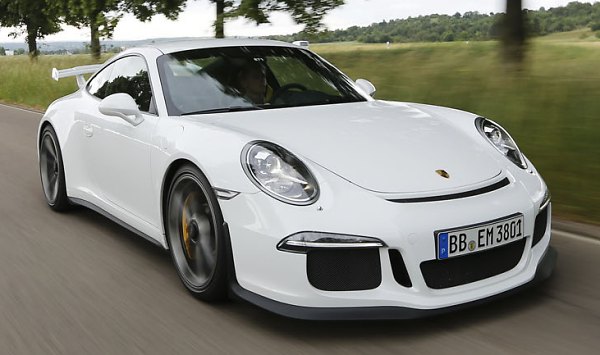 |
|
New
GT3 has abandoned Mezger engine and added 4WS, but the pure driving
excitement is intact.
|
|
When the first 911
GT3 was introduced in 1999, it was supposed to be a homologation
special that only hardcore, part-time gentleman racing drivers would
buy. However, its sharp handling and high-revving engine quickly earned
it the fame as the best-driving Porsche of all – and probably the most
exciting sports car in the world. In the next 13 years, 14,145 GT3s
were sold in 4 generations. The unexpected success drove the management
to make it a permanent model like Carrera and Turbo. In the latest 991
generation, it will take an even more important role…
Since the very beginning, the GT3 had many racing genes. For example,
its so-called "Mezger" engine, designed by motorsport department head
Hans Mezger, was originated from the racing unit that powered 911 GT1.
Its aero package and weight saving measures were closer to race cars
than road cars. However, the new 991 GT3 marks a big departure from its
predecessors. This can be seen in many areas: 1) It switches to a brand
new 3.8-liter flat-six based on the direct-injected unit of production
Carrera S; 2) It abandons traditional manual gearbox for a 7-speed
dual-clutch PDK; 3) It is no longer a striped-out edition. Full
equipment ensures a day-to-day practicality matching other 911s; 4) It
employs an electrical power steering like the regular 991; 5) It
introduces gadgetry 4-wheel steering, the first for Porsche. All these
sound very un-GT3, don't they?
It goes without saying that the 991 GT3 is larger than the old car. Its
wheelbase is 95 mm longer, while overall length and width have grown by
85 and 44 mm respectively. The chassis is constructed as an
aluminum-steel hybrid structure, whereas most external panels are
aluminum sheets. Larger front intakes, deeper air dam and skirts and a
fixed rear wing mark it out from the regular 991 Carrera S. Compare
with the latter, its rear body is 44 mm wider as it adopts the body
shell of Carrera 4.
 |
|
The
PDK alone accounts for 30 extra kilos...
|
|
Despite of the lighter construction and a lighter engine, the use of
PDK gearbox and 4WS, among others, lifted its kerb weight by 35 kg to
1430 kg. The PDK alone accounts for 30 extra kilos.
Speaking of the PDK, it differs from the applications in other Porsches
by using 7 closely stacked ratios instead of 6 normal ratios plus an
overdrive. This mean the 196 mph top speed is reached at 7th gear.
The new 3.8-liter engine shares its block and crankcase with Carrera S,
but it gets the usual treatment of GT3, such as titanium connecting
rods and lightweight forged pistons, to enhance revvability and
throttle response. The cylinder heads are new, featuring rocker arms
instead of tappets to cut weight. Direct injection and the addition of
variable intake valve lift (the "Plus" part of VarioCam) ensure higher
combustion and breathing efficiency. As a result, the new engine is
capable to rev to 9000 rpm, 500 rpm higher than the last GT3 3.8 and
GT3 RS 4.0. It is rated at 475 horsepower at 8250 rpm, 40 ponies more
than the old GT3. Porsche engineers admitted its output rating is
conservative and the actual figure is closer to 500 hp. Maximum torque
of 324 pound-foot is the same as Carrera S. Better still, the new
engine is 25 kg lighter than the Mezger engine, largely offsetting the
extra weight of the PDK box, so the new car is hardly any more
tail-heavy.
According to official figures, the new GT3 can sprint from 0 to 60 mph
in merely 3.3 seconds, down from 4 seconds flat. It is also a couple of
tenths quicker than the GT3 RS 4.0, thanks largely to the faster
gearshift of PDK (which takes as little as 100ms on upshift) and its
associated launch control. 0-100 mph sprint takes 7.5 seconds, compared
with 8.2 sec of the old GT3 and 7.9 sec of RS 4.0. Top speed, however,
barely inches up from 194 to 196 mph. Perhaps more important is the
Nurburgring lap time of 7 min 25 sec, 15 seconds down from the last GT3
and 2 seconds quicker than even the RS 4.0! Technology improves the
breed.
 |
|
The
new engine is capable to rev to 9000 rpm, 500 rpm higher than before.
Better still, it is 25 kg lighter.
|
|
As before, the GT3 is served with some advanced electronic features,
such as adaptive engine mounts and PASM adaptive damping. Now the list
of standard features expands to active rear-wheel steering. At
low-speed maneuvering (up to 37 mph) it counter steers the rear wheels
to improve turn-in response and shorten turning circle. Above 50 mph,
the rear wheels steer in the same direction by up to 1.5 degrees so to
enhance stability. In fact, the feature contributes to the majority of
time saved in Nurburgring. No wonder 918 Spyder and 991 Turbo will also
adopt 4WS.
Braking is also improved. The 20-inch single-nut alloy wheels are an
inch larger in diameter thus enable larger, 380 mm brake discs. As
before, PCCB ceramic brakes are optional. Not that the standard steel
brakes lack stopping power, but PCCB can withstand laps after laps of
abuse thus is preferable for track racing.
In short, the new 991 GT3 is faster yet more sophisticated and easier
to live with. In essence it is quite different to the striped-out,
track-focused GT3 we used to know, even though the last 997 GT3 had
already started migrating to this direction. In fact, under the
pressure of competition (from Audi R8 to Nissan GT-R) Porsche has no
alternatives but to develop the GT3 into an all-round high-performance
model of the 911 family, and leaving the hardcore route to the future
GT3 RS. That makes sense.
On the Road
Open the doors, you will see the Alcantara and carbon-fiber bucket
seats distinguish it from other 911s. The same goes for the Alcantara
trim on the lower half of dashboard and door panels as well as the
steering wheel. Otherwise, the cabin is much the same. It has the same
high-quality dashboard and center console, the same infotainment system
and the same sound insulation, too. Seats aside, it doesn't lose any
creature comfort.
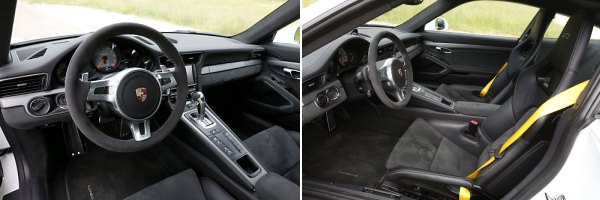 |
|
Seats
aside, it doesn't lose any creature comfort.
|
|
Switch on the naturally aspirated flat-six, prod the throttle, it
responds with an enthusiasm not found on the standard engine. The rev
rises and falls freely as if there is no inertia. The engine runs
smoothly at low rev, more so than the last GT3. It also produces
slightly more mid-range torque, so the performance is more flexible.
No, the 3.8-liter engine is not famous for torque, but now with 7
closely stacked ratios you can use its power band to the full. Each
gearshift of the PDK transmission is completed with astonishing speed
and smoothness. As a result, you lose precious little rpm in gearshift
thus the acceleration is almost seamless. Such a perfect integration of
engine and gearbox is rare – the only one worth comparison is perhaps
Ferrari 458. The small aluminum shift paddles feel good in your hands,
especially as they have shorter travel than other 911s. Having tried
the new PDK, no one would miss the good old manual gearbox.
The addition of direct injection does not alter the classic sound. This
is still one of the most beautiful exhaust notes in the sports car
world. At low to medium rev it is a typical boxer sound, i.e. creamy
yet characterful. From 5000 rpm, it intensifies, getting louder and
harder edge. From 7000 to 9000 rpm is the magic moment, where it really
goes mad and screams like a racing motor. The power and acceleration
are relentless. By this time you would think it must be in the same
league as 458 and MP4-12C!
Despite of the added punch, the 991 GT3 is significantly easier to
drive than the last 997 GT3 or RS 4.0. This is not a surprise perhaps,
because its chassis is 25 percent stiffer, has lower center of gravity,
wider tracks and a longer wheelbase. Still, it is quite incredible that
a car so focused on performance can ride so beautifully. Leave the PASM
at Comfort mode, you can glide over B-roads all day long without
feeling tired. It rides just as good as the regular 911, which is
already a good everyday car. The new car is calmer and more stable than
its predecessor, with less pitch and roll over undulations.
 |
|
Thanks
to 4WS, you no longer need to fight against its rear-biased weight
distribution. The new car is much more neutral and easier to handle...
|
|
Then come the steering. When the 991 Carrera switched to ZF electrical
power steering, some hardcore drivers thought it lost the tactile feel
of the old hydraulic rack. With further fine tuning to the software,
accompanied with sturdier mount and revised geometry, the GT3's system
washes away all doubts. It feels really good in hands. Some of the
small road surface information filtered out by the Carrera has
returned, so you can tell the front end grip and road surface textures
from the helm. It also feels heavier and more direct than the
Carrera's. This is easily the best electrical power steering to date.
Compared with the old hydraulic steering, it feels calmer and weighs
more consistently. No wonder it wins the hearts of motoring journalists
this time around.
However, the most important progress is how much better the new GT3
handles when you push it in a series of corners. Thanks to the effect
of rear-wheel steering, the old car's understeer in corner entry and
oversteer in corner exit have been largely reduced. As a result, it
corners smoother, calmer and with less drama. You no longer need to
fight against its rear-biased weight distribution. The new car is much
more neutral and easier to handle. At the limit, its behaviour is more
progressive, giving you a much wider scope to adjust its line. You can
also use its deep reserve of grip more without fearing stepping over
the limit. The result is faster cornering and a much more
confidence-inspiring drive.
In essence, the GT3's sharp driving experience has not changed a bit in
the evolution to 991 series. It is just made even more capable and
easier to live with. Now it is no longer a hardcore driver's car. Every
keen driver may enjoy the unparalleled driving thrills it brings if he
has £100,000 to spend. Yes, this is still the best 911 of all and
definitely one of the best sports cars in the world.
|
Verdict:      |
Published
on 23
May 2015
|
All rights reserved.
|
|
911 GT3 RS
|
|
 |
|
With
louvered air vents above front fenders and a huge rear wing, the new
GT3 RS looks more race car than ever.
|
|
It is hard to not give the
new 991 GT3 RS a 5-star rating. After all, this car has more power,
more grip and more downforce than the mighty 991 GT3 on which it is
based, and that car won our Car of the Year title last year. The only
questions we should ask are: is it a better car than the GT3 as a road
car? Is it more thrilling to drive than a Ferrari 458 Speciale on
track? Or more relevant to hardcore Porsche drivers, will it be more
memorable than the last 997 GT3 RS
4.0?
At the first sight, the new RS looks even more spectacular, more
track-oriented than the last one. Not only it is benefited from the
advances of the 991-generation aluminum-intensive body, such as a wider
front track, longer wheelbase and lower center of gravity, the RS is
modified further. Its rear wheel arches are obviously wider than the
GT3’s. This is because it is built on the wide-body chassis of 911
Turbo. Like the latter, it sports large air intakes at the rear
fenders, but instead of feeding intercoolers they are adopted to
produce ram effect to the engine at high speed (more on that later).
Behind the rear wheels, an even larger and taller rear wing is mounted
at the tail. So large that it looks as if coming straight from a race
car. Ditto the new louvered air vents opened above the front wheel
arches. They are undoubtedly adopted to release the air pressure built
inside the front fenders thus contribute to downforce. The only thing
the RS misses is a rear diffuser, for which the rear-mounted flat-six
leave no space. However, that massive rear wing is more than enough.
Overall, the car generates 330 kg of downforce at 186 mph (300 km/h),
compared to 190 kg of the last RS.
Downforce adds grip, so do the new rubbers. They are now wider and
larger in diameter – the front grow from 245/35ZR19s to 265/30ZR20s,
while the rear goes from 325/30ZR19s to 325/30ZR21s – so that the
contact patch area gets larger thus generate more traction and grip
than ever.
Moreover, the specially compounded Michelin PS Cup 2 rubbers are
inherently stickier than those on either the GT3 or the last RS.
 |
|
It
now generates so much front and rear end grip that you need a track –
and a fast one – to shake its balance.
|
|
As a result, the new car feels astonishingly planted on the road. It
now generates so much front and rear end grip that you need a track –
and a fast one – to shake its balance. Roadholding is near race-car
strong, especially at fast corners where downforce is built up. Also
thanks to the planted front end, its turn-in is quicker. The retuned
electric power steering feels sharper again than the GT3’s. However, to
extract the most from it you need a fast race track. On public roads,
it is difficult to push the car hard enough to feel its superiority
over the GT3, what a pity!
Perhaps that is why the RS is not as fast as expected on the
challenging surfaces of Nurburgring.
So far Porsche has managed a lap time of 7 min 20 sec on a less than
perfect day. They think it could be good for 7 min 17 sec, but even so
it would be only 8 seconds quicker than the GT3 or 10 seconds better
than the last RS 4.0. Not as quick as its spectacular looks suggested.
I think that has something to do with the lack of improvement on power.
The new 4.0-liter engine is built on the GT3’s
3.8-liter unit rather than the legendary “Mezger” engine which retired
together with the last RS. It is benefited with direct injection and
variable valve lift, of course, but compared with the GT3 engine it is
not a whole lot different. Yes, there is talk of revised cylinder
heads, intake manifolds, valvetrains and lubrication system, but
without specific details we can assume the changes are necessary to
adapt to the larger, slightly more powerful motor. In particular, the
GT3’s titanium connecting rods are retained. The extra capacity is
achieved by lengthening the stroke for 4 mm. This resulted in the
maximum rev drops slightly from 9000 rpm to 8800 rpm, although that is
still 300 rpm higher than the Mezger. Unfortunately, peak output stays
the same. It produces 500 horsepower at 8250 rpm and 339 lbft of
torque at 6250 rpm, not a single horsepower or pound-foot more than the
old engine, which is a shame. Perhaps it just tells
how great the Mezger engine was. The new engine does produce more
power under certain conditions, but that is achieved with the ram
effect courtesy of the new intakes –
at 193 mph top speed, it adds about 10 ponies.
That said, on the road the new engine is still incredible, revving
freely and responsively, making great sound at high rev and producing
respectable punch for a naturally aspirated motor. With reduced sound
insulation, the 4.0 motor sounds even rawer and meaner than the
3.8-liter unit on GT3, although the old RS sounded angrier still. The
compulsory PDK gearbox might be a let down
beside the manual box of Cayman GT4, but as in the case of GT3, it is a
must to match a performance level so high. Moreover, it is very
responsive and accurate, loses nothing except driver involvement.
 |
|
It
keeps most features of the GT3 road car, including air-con, audio...
The days of Renn Sport representing a stripped-out 911 have gone.
|
|
The GT3 RS is actually 3 mph slower at the top end than the GT3 due to
its slightly higher drag coefficient (0.34 vs 0.33) and larger frontal
area. As for acceleration, it is said to take 3.1 seconds to sprint
from 0-60 mph, which is as much as 0.7 sec quicker than the old car.
However, that is purely down to superior traction and responsive PDK. A
clearer picture can be seen from the time it takes from 60 to 100 mph,
which is 4 seconds flat, or merely a tenth faster than the old car.
Lack of extra power is one reason, lack of weight saving is another.
The new car weighs 1420 kg, a considerable 60 kg more than the old car.
Compared with the GT3, it is merely 10 kg less, thanks to using
carbon-fiber front fenders, bonnet and engine lid, a magnesium roof,
plexiglass rear screen and rear quarter windows, less sound insulation,
thinner door panels and fabric door pulls to offset the extra weight of
wider body and larger engine. However, it keeps most features of the
GT3 road car, including air-con, audio, sat-nav, PDK, adaptive dampers,
active differential, rear-wheel steering and adaptive engine mounts.
The days of Renn Sport representing a stripped-out 911 have gone.
On the flip side, the new car is friendlier to drive on road. Although
its stiff suspension still favours race track or smooth Autobahn, ride
quality on country roads is more bearable now. At low speed, the engine
runs and the PDK shifts with a civilized manner you won’t expect on an
RS. The cockpit is also less noisy and more cosy than the past
generations. The only real compromise is the extra width of its body,
which hurts confidence when slipping through narrow country roads. As a
road car, the GT3 is still the more sensible choice, but the RS version
is no longer painful to live with.
This dual-purpose character can be seen as a double-edge sword but it
could be also its identity problem. While the GT3 works better as a
road car and is fun enough on occasional track days, the new RS has
evolved to the extent that it needs absolutely a track to exploit its
potential. Even then it doesn’t feel as emotional or characterful as
the old RS 4.0, nor it is as thrilling to steer, to listen or to watch
as the 458 Speciale. Still a superb driver’s car, but perhaps not the
most special in memory.
|
Verdict:      |
Published on 17
Jun 2016
|
All rights reserved.
|
|
911 R
|
|
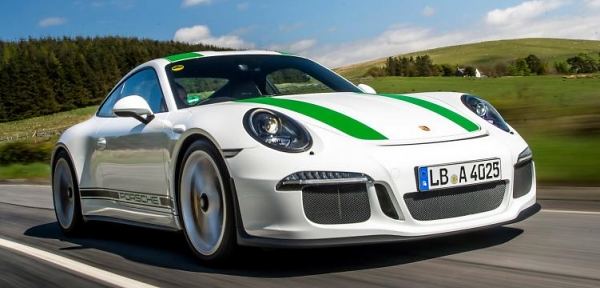 |
|
911
R reuses the existing best stuffs from GT3 and GT3 RS, but fitted with
a manual gearbox to please the hardcores.
|
|
To the hardcore fans of
Porsche, the development in recent years is not comprehensively
satisfying. The latest 991.2 Carrera has switched to turbocharging
which has a slight but noticeable negative effect on sound and
character. While GT3 and GT3 RS keep using high-revving naturally
aspirated motors, they skip traditional manual gearboxes in search for
maximum track performance, which robs the pleasure of pure driver
control. Moreover, the big spoilers of the GT3 duo are designed for
race tracks instead of road use. This means, if you want a proper road
car with naturally aspirated motor and manual gearbox, you have to
downgrade to Cayman GT4 – sorry, even that car is no longer available!
– or look elsewhere from Lotus, Aston Martin or Corvette. Now the
complaint is finally answered by 911 R.
The 911 R is a clever project. It reuses all the existing best stuffs
from the GT3 and GT3 RS but packaged in a road-going body. 991 examples
are slated for production and each asks for a very profitable
£137,000. That’s even more expensive than the GT3 RS! Despite
that, demand is so overwhelming that all cars have been sold before
production begins.
The 500-horsepower, 4.0-liter engine comes straight from the RS. It is
good for 8800 rpm and offers a glorious sound. This is one of the best
motors Porsche ever built and one of the greatest in the world today.
Partnering the engine is not the 7-speed manual you can find in lesser
911s, but a lighter 6-speed gearbox. It is modified from the 7-speeder
with the overdrive ratio discarded and the last 2 ratios stretched so
that maximum speed is reached at 6th. Somehow, its gearshift is also
sweeter, being precise and well weighted, matching the lighter duty
6-speed manual used in Cayman and Boxster. Good news is, this gearbox
will be offered in the next GT3 and RS as well.
While the engine comes from RS, the chassis of 911 R is based on the
narrower GT3, including its front bumper, axles,
suspensions, wheels, tires as well as the 4WS system. However, it skips
the fixed double-plane rear spoiler for the retractable one of lesser
911s so to improve drag and rearward visibility. Part of the lost
downforce is compensated with a new diffuser and flat undertray.
Meanwhile, GT3 RS donates many lightweight parts, such as carbon-fiber
bonnet and fenders, magnesium roof, plexiglass rear screen and rear
quarter windows. PCCB ceramic brakes are fitted as standard to shave
further weight.
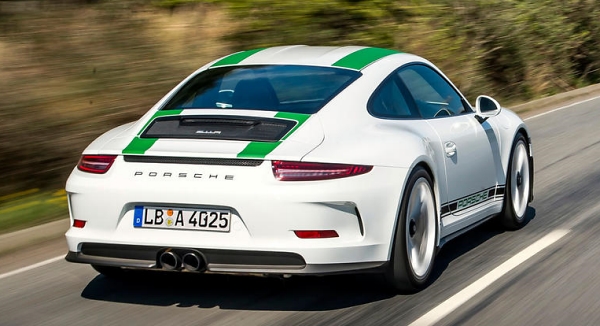 |
|
Slower
than its sisters? yes, but more engaging and satisfying to drive.
|
|
Inside, the 911 R is even leaner than the GT3 duo. Apart from
lightweight door panels and fabric door pulls, it goes one step further
by ditching the air-con
and audio system as well as 4.5 kg of sound deadening materials. There
are classic-looking
lightweight bucket seats up front and no rear seats, of course. All
these efforts result in a kerb weight of 1370
kg, 50 kilos lighter than even the GT3 RS. The manual gearbox alone
contributes to
20 kg saving.
On the road, the 4.0 engine sounds even madder than in the RS thanks to
the reduced sound insulation. As always, it can be tractable and mellow
at low speed and go insane at sky-high rpm. With manual gearbox instead
of the lightning-changing PDK, you tend to shift less frequently and
let the engine staying longer at high revs, hence more chance to enjoy
its glorious soundtrack. On the downside, performance inevitably
suffers a little. Porsche said 0-60 mph takes 3.7 seconds, 0.4 and 0.6
second adrift of the GT3 and GT3 RS respectively, which is quite a lot.
However, in the real world the car feels far faster once its traction
is established.
If you find a clean stretch of Autobahn in early Sunday morning, you
will find its superior top speed. It is able to do 201 mph, the first
time a naturally aspirated 911 breaking the magic mark of 200 mph. At
high speed, you do sense more float and the need for constant steering
correction as it lacks the strong downforce of RS.
Also because of the much less downforce generated, the suspension of
911 R can be tuned softer. The steering and 4WS are also retuned to
reflect the reduced load. As a result, the steering feels much lighter
and more alert, but without losing precision. The ride becomes more
supple. It doesn’t feel quite as locked down to the road as the RS, but
it flows beautifully over bumps, albeit with more pitch, roll and yaw
for the driver to take care of. There are still vast of grip and
traction afforded by those fat Michelin Pilot Sport Cup 2 rubbers, but
the chassis is more sensitive to driver input. To push the car to the
limit, you have to keep concentrated and deliver 100 percent. And then
the car rewards you with sharp feedback and response. Yes, some of the
old-school 911 fun has returned! If we talk about driver engagement
instead of absolute speed, the 911 R has to be the best Porsche today.
|
Verdict:      |
Published
on 24
May 2017
|
All rights reserved.
|
|
911 (991.2) GT3 4.0
|
|
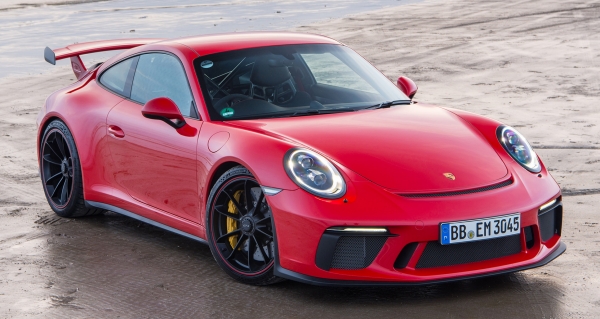
|
|
You
may call it 991.2 GT3, but being a petrolhead instead of IT guy, I
would prefer to call it 991 GT3 4.0
|
|
Production of 911 has just
passed
the milestone of 1 million units. Among them, I suppose GT3
is the purest and the best sub-breed of all. Since the
GT3 was born in 1999, it has been renowned for high-revving fun, sharp
handling and a driver engagement no other road-going 911s could
match. On the basis of GT3, Porsche created the even madder GT3
RS, which is largely oriented to track days, while the GT3 remains
focusing
on the road. Last year, the family got a third member, 911 R, which
mixes the best bits of both cars with a manual gearbox. It seems a big
headache for buyers to choose among them, but in reality, the
decision is rather straightforward. The 911 R is a small batch of
limited production, and its order book closed before you can make up
your mind. Meanwhile, the GT3 and RS always have their production
switched alternately, so which one to purchase depends on when
you have saved enough money or sold your house. The last 991 GT3 ended
production in Feb 2015, then the production line turned to assemble GT3
RS.
By the time
the production of RS ended, now comes the second generation 991 GT3.
You may call it 991.2 GT3, but being a petrolhead instead of IT guy, I
would prefer to call it 991 GT3 4.0, because it is the first time the
GT3 road car employing the largest Porsche flat-six.
Every generation of GT3 engine comes from the motorsport department.
This one is no exception. On paper, it looks like the same unit as the
GT3 RS and 911 R: 3996 c.c., 102mm bore, 81.5mm stroke, 500 horsepower
delivered at a sky-high 8250 rpm and 339 pound-foot of
maximum torque, all exactly the same! But here, the output numbers are
probably a bit conservative. In fact, this engine is NOT derived from
its
siblings. Instead, it comes from the GT3 Cup race car, which is proven
to sustain 24 hours of endurance races. While the
outgoing 4.0 unit revved up to 8800 rpm, this one hits 9000 rpm,
restoring the magic number used to be enjoyed by the shorter stroke,
3.8-liter unit of the last GT3. For a six-cylinder engine so big,
9000 rpm is incredible! Looking around, only the outgoing Ferrari 458
could deliver the same rev, but its flat-crank V8 had a cylinder
capacity of 562
cc, versus 666 cc of Porsche, so the latter is all the more admirable.
Don’t underestimate the technical
difficulties to raise the redline by
a tiny 200 rpm! It takes some thorough modifications: first of all, it
ditches
conventional hydraulic valve adjusters for direct-acting rockers. This
reduces friction and oil pressure thus frees up the valvetrain a bit.
Porsche said it is durable enough for 150,000 miles without
replacement.
Another modification that helps reducing friction is replacing the Alusil
cylinder block of the old GT3 with the latest plasma
spray coating, so that the new pistons can run more slickly inside
the
cylinder walls. To cope with the increased rev and stress, many other
parts have
to be redesigned, such as a stronger crankshaft, bigger main and
con-rod bearings and improved lubrication system. Meanwhile, although
the plastic resonance variable intake manifold looks the same from
outside, inside it has added a second flap, so it is now a 3-stage
design. Not a new tech actually, but it does improve the mid-range
torque delivery and bring forward the peak torque by 250 rpm to 6000
flat. Compared to the last 3.8-liter unit, the new 4-liter has an
advantage of 25 hp and 15 lbft. Meanwhile, the new car weighs exactly
the same as the old, so it is a little bit quicker on straight. A new
GT3 PDK is claimed to do 0-60 mph in 3.3 seconds and 0-100 mph in 7.3
seconds, the former is unchanged, but the latter is 0.2s
quicker.

|
|
Following
the demise of Ferrari 458, this is the last truly enthusiast motor you
can buy!
|
|
That doesn't sound much, but we have reasons to believe the numbers to
be conservative. Evidence One is the stronger low to mid-range torque
you can feel on the road, not only compared with the 3.8, but also with
the RS 4.0. Yes, hundreds of turbocharged cars these days feel stronger
still, but the beauty of the naturally aspirated boxer is that it never
refuses to rev. It loves to do so, and begs you to keep planting the
throttle, listening to its creamy, musical scream, enjoying the
lightning rise and fall of rev needle. Whereas many turbocharged
engines feel flat beyond 5000 rpm, it is only the beginning of happy
hour here. It gets another kick from 6000 rpm, going mad from 7000 rpm
and never gives up until hitting 9000 rpm. Its smoothness and its sound
are intoxicating. Following the demise of Ferrari 458, this is the last
truly enthusiast motor you can buy!
What's more, if you are willing to sacrifice a little straight line
acceleration or lap time, the new optional 6-speed manual gearbox
should give you further engagement and satisfaction with its sweet
gearshift. Coming straight from the 911 R, it also saves the car 17 kg
– part of that is down to the mechanical LSD instead of the PDK's
electronic LSD (note: the active LSD needs the PDK's hydraulic pump to
serve, so it is not compatible with manual).
Back to the PDK car, if you think its straight line performance
advantage over the old GT3 too slim, try it on a circuit. Porsche found
it took only 7:12.7 to lap Nurburgring, compared to 7:25 of the old
car. More amazing, it is also quicker than the GT3 RS, which was said
to be capable of 7:17 on a perfect day. Since the GT3 lacks the RS'
extra downforce (it produces 155kg at top speed, while the RS made
330kg at 186mph), you can see its engine must be stronger, and the
chassis tuning should be better again.
At a glance, the chassis looks largely unchanged from 4 years ago. It
is still based on the "wide body" of Carrera 4S, if not as wide as the
RS. The front and rear bumpers are now made of polyurethane, saving 1
kg each side. Front intakes have been enlarged, as are the scoops on
the engine lid. By reworking the underbody paneling and mounting the
(same) carbon-fiber rear wing 10mm higher and 20mm further back,
downforce has been lifted by 20 percent without generating extra drag.
The adaptive dampers, active engine mounts, 4-wheel steering and both
sets of brakes are kept unchanged. The front suspension is retuned
subtly, while the rear suspension gets helper springs so that the main
springs can be made shorter, lighter and stiffer to improve body
control yet still capable to keep the inside wheel firmly on road
during
hard cornering. Lastly, the new version of Michelin Pilot Sport Cup 2
tires with bespoke compounds should generate a bit more grip.

|
|
The
GT3 is so sharp, its action so immediate and its response so
interactive to your commands.
|
|
On public roads, the new GT3 remains the fastest, most engaging yet
accessible machine you can dream of. Its engine and PDK are so
responsive. Its body control is so tight, its agility is so good,
but its roadholding is so strong that you need to be brave and silly to
shake its tail on a proper road. The steering is the best among all
electrical systems, being precise, perfectly weighted and
communicative, even though not quite as tactile as the 997’s hydraulic
rack. The suspension is predictably firm but it rides very well on
regular roads, and it soaks up the bumps and undulations on B-roads
effectively, unlike an AMG GT R or Jaguar F-Type SVR. This is a car you
can drive all day long.
Meanwhile, on a race track it becomes another animal. With enough space
and speed, you can fully unleash its wild side. Its body control is
still impeccable, and the grip, traction, steering and braking still
come
together, but if you push it deep and violent enough, you will turn its
slight initial understeer into oversteer, which is not as subtle as a
mid-engined Ferrari or McLaren for sure. Give it a quick
counter lock and a boot of power, its tail steps out immediately, and
you can make it dance on the knife edge. Back off immediately
and flick the steering wheel again and it settles. The GT3 is so sharp,
its action so immediate and its response so interactive to your
commands. Its handling is so adjustable. Comparatively, a McLaren 570S
sounds too benign to be exciting. The 911 still offers the evil side
of a rear-engined machine for you to access, to test your driving skill
and to reward you with immediate feedback, but ultimately it won’t bite
you like an old-school 911.
Although many things look the same as before, the new GT3 is a
considerable improvement. Most important, it hasn't forgotten what made
the old car so great to drive, and it works even harder to promote
these qualities. Porsche
has once again lifted its bar and
created the most engaging sports car in the world. Even though its
price has been raised by 10 percent, at £111K it still looks a
bargain. Good job!
|
Verdict:      |
Published
on 9
May 2018
|
All rights reserved.
|
|
911 (991.2) GT3 RS
|
|
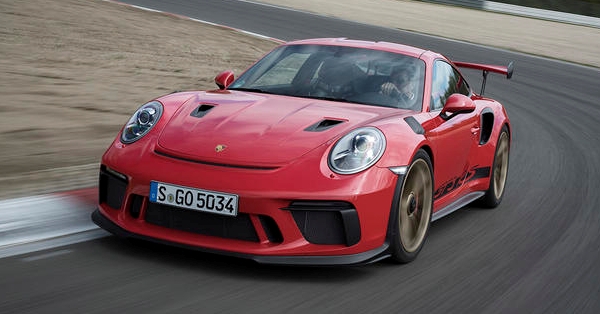
|
|
The
GT3 RS combines the best of both worlds: the naturally aspirated engine
of GT3 and the strong chassis of GT2.
|
|
Given the long history of
RS, which started in 1973 and reborn under the GT3 badge
in 2003, I suppose by this time you should know the essence of the
Rennsport line. Yes, it is built by the motorsport department as the
most track-oriented road car of Porsche, more so than
the GT3 and GT2 RS. Moreover, given the track records of
the last few generations, it is fair to say this is the best
hardcore driver’s car in the world at any prices. There are plenty of
supercars going faster, but none can quite match the communication,
response and simply the thrills it brings on both road and track.
The latest GT3 RS is the last derivative of 991.2, which is slated to
be replaced by 992 next year. Having evolved for
so long based on the same formula, and its normally aspirated engine
has been capped at 4.0-liter since 2011,
frankly, I wonder how much progress it could make this time around. The
new GT3 is already an amazing machine, and it has adopted a 4-liter
engine, too. There seems to be little headroom left for the RS,
isn’t it?
Then Weissach suddenly dropped a bombshell to the motoring world: the
new RS lapped Nürburgring Nordschleife in 6:56.4, taking the 3rd
spot of the road car chart, trailing just the GT2 RS (6:47.3) and
Lamborghini Huracan Performante (6:52.0). It improves on the old car by
about 21 seconds and beats the new GT3 by 16 seconds. Such a margin is
incredible!
Well, that was actually achieved with a trick: Michelin Pilot Sport Cup
2 R
N-spec. Those super-sticky rubbers produce even more grip than the Cup
2 tires fitted standard to the GT3 RS. They are barely legal to use on
road but don’t last as long or work as well on wet. No
wonder they are available only as dealer-installed option. Undoubtedly,
a large part of the
improving lap time is down to these rubbers. Without them, the car
would have been faster than a GT3 by less than 10 seconds.
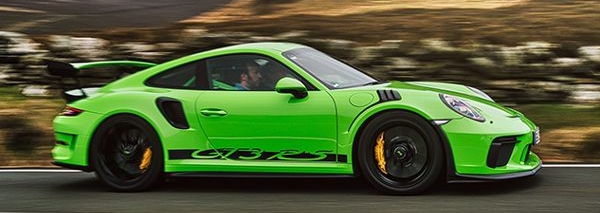
|
|
With
stronger grip and downforce, it corners faster than any road cars
Porsche has ever built.
|
|
However, the RS is still a solid improvement from the GT3. While its
engine is practically the same, the revised ECU and a new titanium
exhaust release another 20 horsepower at the top end and 7 more
pound-foot of torque at 6000 rpm. Its redline is the same 9000 rpm, or
200 rpm higher than the old RS. The combination of new exhaust and
reduced sound insulation results in an angrier noise, which is so
violent and addictive from 8000 to 9000 rpm. Predictably, the engine’s
throttle response is razor-sharp. It revs freely and the power output
is linear. It is so much more engaging to exploit than the turbocharged
motors of
GT2 RS and most rivals. Meanwhile, the PDK gearbox – unlike GT3, no
manual option here as lap time is essential – shifts even faster than
the GT3’s. In other words, the gearshift is close to peerless.
Admittedly, the extra horsepower and torque over the GT3 is rather
modest, so the car is only a tenth quicker in 0-60 mph, now taking 3.1
seconds. Top speed is actually dragged down by the massive aero kits to
194mph. In case you adjust the spoilers to maximum angles, it drops
further to 191mph.
In return, you get twice the downforce of the GT3, 7-8 percent more
than the old RS and 10 percent more than the GT2 RS. Unlike a McLaren
Senna, the Porsche does not generate much ground effect due to its
rear-mounted engine which occupies the space for a diffuser, but it has
a massive rear wing, deep lip spoiler, side skirts and smooth undertray
to generate downforce, which amounts to 145kg at 124mph, 500kg at
186mph and 586kg at top speed. Externally, the aerodynamic design
doesn’t look much different from the old car. There are louvered vents
over the front fenders to release air pressure built inside the wheel
wells. The rear spoiler looks the same, too, but it is actually a bit
wider. Like GT2 RS, its front bonnet is added with a pair of NACA ducts
to cool the brakes. This removes the brake ducts from the nose to
smooth the airflow for more downforce.
It is built on the Turbo’s body thus both tracks are wider than those
of the GT3. It runs on 265/30ZR20 and 325/30ZR21 tires, fatter than the
GT3’s and ridiculously match the heavier and torquer GT2 RS. With
bespoke compounds, the mechanical grip and traction are massive. In
addition to the superior downforce, no wonder it corners faster than
any road cars Porsche has ever built.
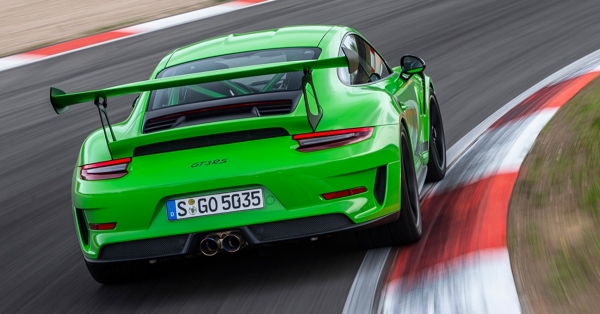
|
|
Thanks
to the rigidly mounted suspensions, you feel yourself more connected to
the car...
|
|
Most of its chassis goodies are carried over from its siblings, such as
4-wheel steering, adaptive engine mounts, adaptive dampers, torque
vectoring differential and optional PCCB brakes. In addition, the GT2
RS donates its lightweight stuffs, i.e. carbon-fiber bonnet, front
fenders and engine lid, as well as magnesium roof, so it weighs the
same as the narrower GT3. If you opt for Weissach pack, you can drop a
further 28kg thanks to carbon-fiber roof, rear wing and anti-roll bars
and forged magnesium wheels. Most important perhaps, it gets also the
GT2 RS’ rigidly mounted suspensions, which use ball joints instead of
rubber bushings to eliminate slack, sharpen response and feel.
Moreover, its springs are stiffened by 100% up front and a third at the
rear compared with the old car, very close to the level of GT2 RS.
As seen, the GT3 RS combines the best of both worlds, i.e. the
naturally aspirated engine of GT3 (but have it enhanced slightly) and
the strong chassis of GT2 RS (but retuned to take advantage of its 40kg
weight saving and better balance). How does it perform on track? In a
word: Marvelous! Its grip, traction, body control and stability are all
beyond the level of the old car. Thanks to the rigidly mounted
suspensions, you feel yourself more connected to the car. There is
virtually no lag between your steering input and the moment the nose
responds. Moreover, the steering feeds even more details to your hands
– you won’t believe that it is assisted electrically – but without the
unwanted kickback and corruption. The car’s turn-in is even sharper.
There is less initial understeer to overcome, less than the GT3 or the
old RS, so it feels cleaner and more precise to place in corner.
Mid-corner, the great balance allows you to induce slide at will, and
you have plenty of options to determine the attitude. This car lets you
forget that its engine hangs over the rear axle. The brake is also
predictably strong and matched with perfect pedal feel.
The extra response and precision over the GT3 and old RS is also
evident when compared with the GT2 RS, mainly because the GT3 RS feels
lighter. Its linear output and sharp throttle response are also more in
sync with the superb chassis. For pure driving engagement, this car is
better than the GT2 RS.
So what’s not to like? With stiffer springs, the ride is slightly on
the firm side (though might be acceptable for hardcore drivers). The
rigidly mounted suspensions and wider tires transmit a lot of noises
into the thinly insulated cabin. It is not as good a road car as the
GT3, obviously. The price of £141,000 is also a bit expensive,
putting McLaren 570S, Audi R8 V10 Plus, Honda NSX and Mercedes AMG GT R
to its direct rivalry. The Porsche might lack the exotic look and feel
of them, but it is a better driver’s car, especially for those
regularly take their cars to track.
|
Verdict:      |
Published
on 25
May 2019
|
All rights reserved.
|
|
911 (991.2) Speedster
|
|

|
|
For
the first time, the Speedster is derived from the hardcore GT line.
|
|
Porsche used the label
“Speedster” a few times before. The earliest 356 offered a Speedster
body as a permanent option. It was characterized by a purer form and
lightweight treatment, thanks to a cut-down windscreen, a simple canvas
top and spartan interior. Entering the 911-era, the Speedster name had
been forgotten for a while. It was not until 1989 that Porsche
resurrected the label. It became a limited production edition
introduced at the end of the lifecycle. 1993 saw
another Speedster arrived as the farewell edition of 964. Then it was
forgotten again. The first water-cooled 911, 996, skipped the Speedster
conversion, but its successor 997 got one in 2011 – yes, again at the
end of its lifecyle. Only 356 units were built. All these 911
Speedsters were developed based on the contemporary Carrera, Carrera S
or GTS etc. They retained the cut-down windscreen and lightweight soft
top, but they were no longer lighter or faster than the equivalent
coupes, regretfully. People bought them simply for style or rarity.
The latest 911 Speedster follows a similar formula. It is the final
member
of the 991 generation. It is also a limited edition, although you might
say 1948 examples are not so limited. However, one thing – and very
important thing – it breaks away from its tradition: instead of the
mainstream 911, it is now derived from the hardcore GT3 line.
Its close cousins include the GT3 RS and 911 R. Speedsters have never
been so exciting.
The Speedster starts life from the body of Carrera 4S Cabriolet. It is
fitted with a cut-down windscreen (which reduces frontal area), a
manually operated fabric roof that weighs only 10kg and a camel-back
hood cover made of carbon-fiber. Its front bonnet, front fenders are
also converted to carbon-fiber, which is an easy job because Porsche
already made these for the last 911 R. The chassis and suspensions are
taken from the GT3. It keeps the same springs but adaptive
dampers are softened a little, as it is oriented to road use. The 4WS
is also retuned to compensate the loss of rear downforce. To compensate
for the loss of rigidity, Porsche reinforced various locations of the
chassis, including a cross brace located behind the cockpit. The rear
seat is sacrificed to accommodate this brace and the soft top. Even so,
the Speedster loses 20 percent torsional rigidity compared with the
GT3, and its kerb weight is upped by 52kg. And the latter is already
helped by the standard fitment of PCCB brakes.
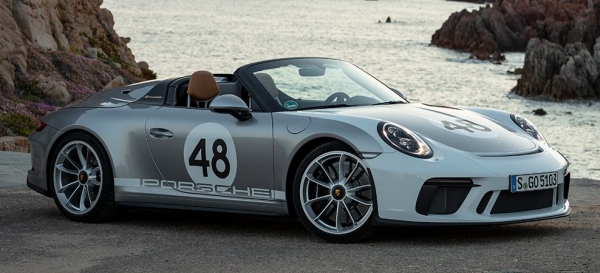
|
|
Few
would buy the Speedster for speed. Instead, they are looking for
maximum fun.
|
|
It seems to be a less hardcore machine, but the powertrain might
compensate a little bit. The 4.0-liter engine sounds like the one
serving the GT3, but it is actually a further evolution. Key
changes include a higher fuel injection pressure and individual
throttle bodies. The latter sharpens its throttle response further. The
new motor keeps its magic 9000 rpm redline, but its power delivery is
even stronger between 6000 and 9000 rpm. Maximum power is now developed
at 8400 instead of 8250 rpm. Its absolute value is said to be 510 hp
(DIN), or 10 ponies more than the GT3’s, but on the road it feels more.
It might be deliberately underrated to avoid embarrassing the GT3 RS.
Maximum torque is 347 pound-foot, identical to the RS and 8 more than
the GT3. This improvement becomes even more respectable if you realize
the new motor has added particulate filters to meet new emission
standard. The motor is attached to a new
lightweight titanium exhaust.
Like the 911 R, the Speedster comes exclusively with the close-ratio
6-speed manual gearbox of the GT3. Many GT3 buyers opted for PDK to
optimize performance, but the Speedster is not about track times.
Instead, maximum driving satisfaction is key to its creation.
With more weight, more drag and a manual gearbox, the Speedster is
predictably the slowest member of the GT family. Its terminal velocity
is 192 mph (6 mph down from GT3 with PDK box), 0-60 mph takes 3.8
seconds (half a second longer) and 0-100 mph takes 8.0 seconds (+0.7s).
A McLaren 600LT probably will do 0-100mph in 6 seconds flat.
Apparently, few people buy the Speedster for speed.
If they look for maximum fun, then the Speedster is hard to complain.
Turbocharging might be great, but it can never deliver the thrills of
winding the motor to 9000rpm, listening to the orchestra at high rev
and the roar at every prod of throttle, and this is despite the fact
that the particulate filters turned down the noise a little. The
throttle response of this incarnation of GT motor is so sharp to the
extent that sometimes you wonder if it is too sensitive for road use.
Meanwhile, the 6-speed manual gearbox is sweet. Slick, precise and
short-throw. The ratios are closely stacked. It is a joy to row.
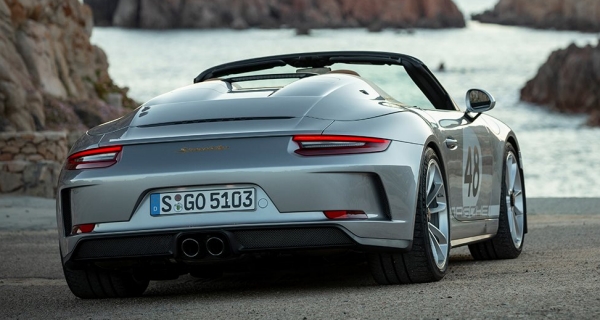
|
|
The
roof is not the highlight of the car, ridiculously.
|
|
On the road, the Speedster drives nearly as good as the GT3. The
steering is feelsome and faithful. The nose turns instantly. The Cup 2
tires generate masses of grip. The braking is sensational. The softer
suspension delivers a supple ride. There is a touch more body roll, but
it is progressive, just like the balance at the limit. It flows fluidly
from corner to corner. On a track, it won’t match the GT3 for speed,
blame to the loss of chassis rigidity and downforce. However, on public
roads the handling advantage of GT3 is too slim to speak of, while the
softer ride of Speedster is more welcomed. In many ways, it drives more
like a 911 R.
The Speedster gets a pair of superb bucket seats from 918 Spyder. The
shorter windscreen does not bring more buffeting, but the raised rear
deck does reduce rearward visibility. What about the roof? Well, it is
not the highlight of the car, ridiculously. You may buy a Ferrari 488
Spider over its coupe sister in order to hear more the engine noise. On
the 911 Speedster, the open top is counterproductive, blame to the
extra wind noise and the long distance between the cockpit and the
rear-mounted engine. It might be better to close the top and let the
engine noise to penetrate within the body shell. The fabric roof is
electrically unlatched from the windscreen header, but you need to go
out to raise the rear deck and fold the roof by yourself.
The most controversial is pricing. It sells for $276K in the US and
£212K in the UK, nearly double the price of the GT3 ! That makes
it 50 percent more expensive than the 911 R, and uncomfortably close to
the level of Ferrari 488 Pista (£253K). If it were priced just
slightly above the GT3, it would have got a 5-star rating. Since it is
priced against supercars without offering the same supercar-level of
performance and sense of occasion, it has to settle at 4 stars.
|
Verdict:     |
|